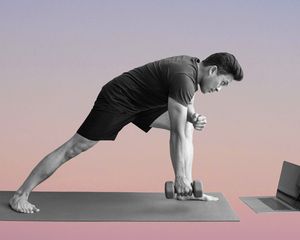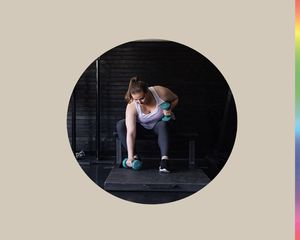
Artem Varnitsin / EyeEm / Getty Images
Consistent workouts are the key to seeing your hard work pay off. The best way to be consistent is to make a plan—one you can stick to. And that means it needs to motivate you and fit your schedule.
With strength training, there's an abundance of ways to design a routine depending on your ambitions and lifestyle. But the science is clear on one thing: For the best results for strength and muscle growth, you need at least two sessions per week. That being said, depending on what your specific goal is and how much time you have to devote to training, choosing how to split up your workouts across the week can be confusing.
To find out the optimal ways to design a workout split and which routine may work best for you, we spoke to trainer Brock Davies and sports physical therapist Sandra Gail Frayna.
Meet the Expert
- Brock Davies is a NASM-certified trainer and CEO of HOMEBODY Fitness.
- Sandra Gail Frayna is a physical therapist with Hudson Premier Physical Therapy & Sports
The Value of Workout Splits
Workout splits allow you to divide the volume of your workouts over the course of multiple days, so you can potentially shorten your workout time while achieving excellent results.
Davies says that workout splits are valuable for anyone wanting to maximize their time and effort. "Workout splits are key for people that want to build muscle and work out on a regular basis. When you are constantly working out the same muscle, you are not allowing time for your muscles to recover and repair," he says. "Rest and recovery are just as important when it comes to building muscle and working out."
Splits can also help with your workout-life-career balance. Frayna explains: "Workout splits are valuable when it comes to working out because consistency and rest are the two most important parts of seeing results in the gym while also living your best quality of life. Dividing up the workout can allow you to better reach your goals."
Types of Workout Splits
There are three main types of workout splits:
- Body Part Split: Dividing workouts to focus on specific body parts during each training session. These can be combined, such as back and biceps, chest and triceps, etc. Body part splits are typically five days per week splits.
- Upper Body/Lower Body Split: Workouts are divided into upper and lower body training sessions. You may focus on specific parts of your upper and lower body in each session, but you will typically work them each twice per week, with a four days per week training schedule.
- Push/Pull/Legs Split: Three types of workouts that alternate. Workouts are divided into pushing exercises such as chest presses and shoulder presses; pulling exercises such as rows, pull-ups, and bicep curls; and a legs session. You can do these splits on a three-day or six-day per week training schedule.
Pros and Cons of Workout Splits
Each split has its pros and cons, and each has the potential to help you achieve excellent results. Here are the pros and cons of each, according to the experts.
Body Part Split
- Pros: "The benefit of body part splits is that you will work out every muscle equally," says Davies. "This allows your muscles equal time to work out as well as time to recover while working out other muscle groups."
- Cons: The disadvantage of body part splits is that you will only work out this muscle group once per week. "The infrequency of working out a certain muscle group might result in the inability to perfect the form in certain workouts. The pros and cons of the body part split are all dependent on your own personal goals," says Davies.
"Body part splits allow your muscles equal time to work out as well as time to recover while working out other muscle groups," Frayna explains. The catch? "It might take more time to see results since you are not consistently working out the same muscle group."
Upper/Lower Split
- Pros: "Splitting your workouts by upper and lower allows you to maximize muscle gains. You can switch the days you work out the upper and lower body, as well as work in active recovery," says Davies. Frayna concurs: "A pro of the upper-lower split is that you can concentrate on certain muscle groups with ample time and also allow some time for rest. Working out muscle groups evenly is key to living in a healthy body."
- Cons: "The con of this split is that you do not get as much recovery time for the muscles," Davies says. Additionally, "you might favor some muscle groups if you do not create a coherent workout schedule," warns Frayna.
Push/Pull/Legs Split
- Pros: "The pro of the push/pull/legs split is that all the muscle groups that work together will be worked out at the same time, and there will not be overlap when creating the workout schedule," Davies explains. "This allows for the recovery of muscles. It also allows you to see your progress through the progression of reps."
- Cons: "The con is that it will not target your weaker muscle groups," says Frayna. "You must make it a point to work out all of the different muscle groups," Davies adds.
How to Choose a Workout Split
Choosing a workout split might seem intimidating, but you are sure to see results no matter which split you choose—so the optimal choice is likely the one you can see yourself sticking to consistently. And of course, you can always switch up your split in the future. In fact, changing your routine might help you progress long-term.
"The best workout split is the workout that you can fit into your daily routine most seamlessly and allows enough time for your muscles to recover," Davies advises. "Recovery is a major part of working out, whether you are a beginner or advanced in the world of working out. If you do not give your muscles enough time to repair themselves, it will become very difficult to engage the correct muscles when working out, leading to injuries."
Frayna agrees, stressing that when it comes to working out, there is never a one size fits all approach. "You can try out these different splits and see what works best for your lifestyle and goals. The body part split would be best for beginners. This allows you to take time to learn about all the different workouts and have optimal recovery time. For intermediate, I would recommend push/pull/legs because you are working out related muscle groups together and growing those muscles."
Splits vs. Full Body Workouts
Another popular option for workouts is the full-body training session. The difference is you hit your upper and lower body in the same session as opposed to splitting them up in any way. You can choose different exercises that target every muscle group for each session. There are definite benefits to full-body workouts that you may wish to consider.
"Both body parts split workouts and full-body workouts have their advantages and disadvantages," says Davies. "The benefits of split workouts are being able to keep track of your schedule and progress; this removes the unknown that comes with full-body workouts. You can have a strict schedule of which muscle you are working on that day, and rest appropriately."
Full-body workouts have the advantage when it comes to overall calorie burn. "With a full-body workout, you can hit all the muscle groups in one workout which burns a higher amount of calories," says Frayna.
But with full-body workouts, there is less focus on specific muscle groups. "A pro of split workouts is that you will cause less strain on your body since you are concentrating on one muscle group at a time," notes Frayna. "A disadvantage of a body split workout is that each muscle group is only trained once a week, so you might be favoring certain muscle groups. At the end of the day, the best workout is the one that you can maintain a healthy schedule with."
"The cons of body split workouts are the imbalance of muscle gains and inflexibility to your schedule," adds Davies. "Conversely, the advantage of full-body workouts is that there is more flexibility in the amount you work out because you worked out every muscle group in one day. The con is that your muscles need rest to grow so you might not be able to work out as consistently. Both workouts have their pros and cons. It is all dependent on your goals."
The Final Takeaway
No matter how you choose to divvy up your strength training, the most crucial factor is consistency. As long as you are recovering well and using progression, any split you choose will provide results. Choose a split that fits into your current schedule and go from there. Every few weeks you can evaluate and change up your split or switch to full-body workouts if you'd prefer.
















